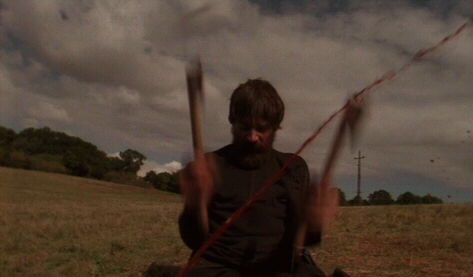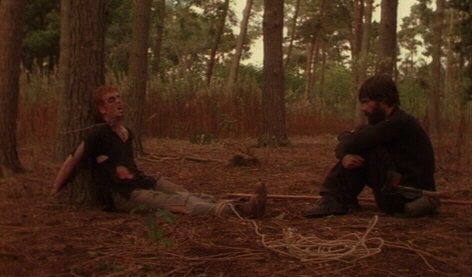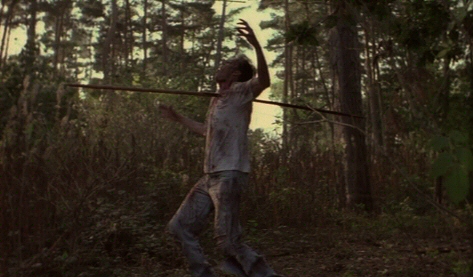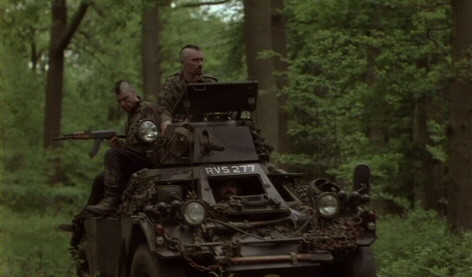Following a successful run on the festival circuit (after premiering at Dead By Dawn earlier this year) new post-apocalyptic indie shocker THE VANGUARD is unleashed on DVD so to celebrate the occasion SGM's Stu Willis kicks back with director Matthew Hope to discuss his debut breakthrough movie…
Stu Willis: Congratulations on the film. Where and when was the film shot?

Matthew Hope: The film was shot for the most part in and around Hertfordshire. The path that Max rides his low rider along at the start of the film was actually used in Band of Brothers. It was shot in September 05 with a few additional shoots in 06.
Stu: Can you talk a bit about the motivations behind the screenplay? What begins as a post-apocalyptic gorefest blossoms into something more politically aware. There's a lot being said in what is essentially quite a short script, especially with regards to population control, immigration, genetic experimentation etc. Can you elaborate on the views that formed your screenplay?
Matthew: I'd been thinking about doing a film just about a man from an industrial society trying to survive as a hunter/gatherer in a post-apocalyptic world. The decline of the western world was a subject matter I'd been reading about for a long time. I think the subject matters the film deals with are a real concern, especially Peak Oil - which hardly anyone was discussing at the time, but is now upon us. The genetic experimentation came more out of the War on Terror and what was being done to people around the world - the Trackers became an kind extreme take on that - if they were subjecting people to torture, then perhaps it wouldn't be long before Governments moved on to genetic experimentation - all in the name of freedom and democracy. It's not too dissimilar to what the Nazis did in World War 2.
Stu: I imagine filming outdoors with a small crew carried its fair share of logistical nightmares. What were the biggest problems you encountered?
Matthew: Time and daylight. They were the biggest by far. We shot the bulk of the film using natural light. Scheduling cast and crew was also very hard. We'd have days where we could use blank firing guns, but the actors deaths would have to be shot on a different day because we couldn't get the special effects crew on the same day.
Stu: What prior experience as a director do you have, and how did it come into use while making "The Vanguard"?

Matthew: I had only made one short film prior to The Vanguard; a short war movie called In The Field. I'd worked on other films as a PA and as an Assistant Director. The biggest lesson I took from the short was to be prepared. I planned meticulously so that when problems arose I would have some kind of idea of how to solve them. It also gave me a good understanding of lenses and working with actors and also how to cover a scene in order for it to work. A short also teaches you that when the light is going you just have to get the shot and can't worry about if it's perfectly framed, you just have to get it or the scene won't work and you'll be left with a massive hole in your film when you come to edit it.
Stu: What have you learnt from making the film?
Matthew: Pretty much everything about the filmmaking process, from inception to completion.
Stu: Describe your relationship with the cast, both on and off set.
Matthew: I had a great cast, both professionally and personally. They all got what I was trying to do and just mucked in. Most of them I had either worked with before or knew socially. Ray Bullock Jnr who plays Max in the film was a great sounding board during the writing of the script and really helped to develop the character of Max. Jack Bailey who plays the lead Biosyn created all the Biosyn movements. All the actors brought something to their characters; I openly encouraged this because it allows them to be at their most creative and exciting ideas can come out this process.
Stu: How did you go about financing the film? What was the overall budget?
Matthew: The film was financed privately. The budget I'm not a liberty to discuss unfortunately, but in some respects I believe we made it look like a lot more.
Stu: Some of the FX seem quite elaborate for a small film. Can you talk us through them: who were the team responsible, how did you enlist their expertise, what problems did you encounter etc?

Matthew: Initially I approached Paul Hyett (The Descent, Doomsday) who I knew through a director friend and asked if he'd build me some prosthetics - which he kindly did, but then he had to leave for another film, and handed the job over to Robbie Drake, who did most of the effects, arms and legs being hacked off, blood spraying, etc. We actually had leftover blood from The Descent that Paul gave us. There are a couple of effects I'm particularly proud of. A local carpenter built one. The spear through the neck that you see at the start of the film cost me £15 and was very simple to achieve - David Osborne made a plate that sat on the actors shoulder with two prongs coming out of it that they spear attached to. It's very simple but looks great. The other effect is the blood gushing out of the Tracker's chest at the end. Phil Anderson achieved this with a beer barrel filled with fake blood and a tube. We tweaked it later in post to make it seem like there was more blood pumping out. We had no real problems, it was just some of the effects took a long time to set up, and as I said before we shooting with natural light.
Stu: The film reminded me of a cross between "Mad Max", "28 Days Later" and "The Omega Man". What personal influences did you bring to the film?
Matthew: All three of the films you mentioned were influences, particularly The Omega Man and its opening which has very little dialogue. The other influences were 2001: A Space Odyssey (where we got the idea of having the Biosyns be ape-like) and Kurosawa's film throne of Blood (that's where the make up came from - Japanese Noh theatre). Samurai films were a big influence on the film.
Stu: There is very little dialogue in the first half of the film, save for narration. Was this a stylistic preference, or more to do with budgetary restrictions?
Matthew: Having no dialogue at the start was purely a stylistic preference - again it goes back to The Omega Man. At one point my DoP David Byrne and I thought about having no dialogue at all! A lot of the narration we added later on just to clarify what had happened to the world the audience was being presented with. We also wanted to make the film as visual as possible.
Stu: What was the most restrictive part of working on a budget?
Matthew: The most restrictive part of working on a budget is not being able to have things like cranes or tracks. We did use a steadicam that I think helps a lot in the film. Also, I would have had a lot more blood letting. With a proper budget I would have had the Biosyns be able to really leap around and wires could've achieved this. I had to have the actors speak about the world instead of showing it, which again is limiting.

Stu: How on Earth did you manage to incorporate tanks and helicopters into the action?!
Matthew: The tanks we got from a place called Tanks-a lot where you can drive tanks for the day. I went and asked the owner if we could come along and shoot a sequence for the film. He was really cool about it and I wrote a scene to incorporate them into the film. The helicopters we got by standing outside an RAF base and just filming them taking off. We were able to achieve this because my DoP owns an Eyemo camera that is a small World War 2 camera that takes 100 ft rolls of film.
Stu: Is there anything you really wanted to show or do in the film, but had to concede due to budget?
Matthew: All the stuff I mentioned in the above question.
Stu: Conversely, what's your personal favourite moment or aspect of the film?
Matthew: I really like a lot of the opening part of the film with Max alone in the wilderness. I also wish I had spent more time rewriting the second half of the film. But that's in hindsight. I wrote it with a budget in mind, but it did have big ideas. That's one of the reasons its setting is not named; I wanted it to able to be anywhere and play anywhere.
Stu: When it comes to marketing of the film, how - if at all - have you been involved?
Matthew: Lionsgate have consulted me throughout the marketing, which is great, as I had heard that sometimes distributors just take the film and do what they want with it. It's been invaluable to see the film through from beginning to end. Lionsgate have been my last collaborators and I couldn't be happier. They really got the film and have done a great job.
Stu: The film has played on the festival circuit. Can you recount some emotions of how this has been for you, travelling and presenting your film to various audiences?
Matthew: Being put up in a 5 star hotel was awesome - a first for me! It is nerve wracking at times because these audiences are the first people to see the film and at this point you have no idea how the film will be received. I spent 3 years making the film! But every festival we've been to has been great. I think it's both instructive and informative.
Stu: From touring the festivals, can you recommend any other modern horrors that people may have missed?
Matthew: Although not a horror film, I saw Shawn Linden's Nobody at BIFFF which I really liked.
Stu: Do you envisage a sequel to "The Vanguard"? If so, can you clue us in on what would possibly happen next?
Matthew: I did map out a sequel, but I guess we'll have to see how The Vanguard does first, and also it would have to have a huge budget!
Stu: What's next for you - do you have any projects currently lined up?
Matthew: I'd like to do a revenge film next.
Stu: All the best, and thanks for your time!
Special thanks to Matthew Hope, Lions Gate Home Entertainment and Lucy at Market Me